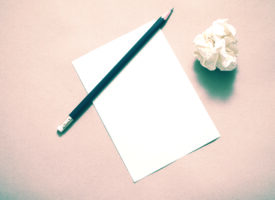For freelance writers with a desire to still bring out the Shakespeare and Robert Frost in them after a day’s work, there are places for your lyricism: blogs, self-publishing, literary publications, and even poetry writing competitions.
However, poetry is not just about fusing words and rhythm. There is some labor involved here, and it’s going to hurt. A poet’s work, according to Indian British novelist and essayist Salman Rushdie, is “to name the unnamable, to point at frauds, to take sides, start arguments, shape the world and stop it from going to sleep.”
But how do you wake up the world through poetry? First, understand what it is. Second, look around and dig deep.
Understand it: Poetry
The word poem, which origin can be traced through the Greeks, is from the verb “poi-eo” which means “to make, to do.” However, it was used in Greek to refer to “any construction or any product that is put together” and not necessarily to the poem that we know today, according to the Middlebury College.
Today, a poem is defined as “a piece of writing that partakes of the nature of both speech and song that is nearly always rhythmical, usually metaphorical, and often exhibits such formal elements as meter, rhyme, and stanzaic structure.”
Forms of poetry
You can choose which of these forms match your style:
Lyric poetry
This is considered as the most personal form of poetry. It talks about the poet’s life: delights and desperation, rage and agony, love and lust, misfortune, transitions, and golden, utopian days. Under this category are:
- Personal lyric: The personalities of the speaker and the poet are parallel.
- Sonnet: Contains 14 rhyming lines of equal length: iambic pentameters in English, alexandrines in French, hendecasyllables in Italian.
- Dramatic Monologue – It takes place as a theatrical monologue: the poet is delivering lines as a character, a fictional identity, or a persona.
- Elegy: A formal poem for the death of a person.
- Ode: A long type of poem with various lengths and elaborate rhyme patterns that usually praise a specific subject. Pulitzer Prize winner Pablo Neruda is known for his odes, such as Ode to a Large Tuna in the Market, Ode to My Socks, and Ode to the Sea.
Narrative Poetry
This type of poetry offers a verbal representation of a story. Its forms are epics, such as Virgil’s Aeneid, mock-epic, and ballad.
Didactic Poetry
The type of poem for instructions and practical work. An example of this is Hesiod’s “Works and Days” which describes a farmer’s almanac, a description of work to be done at different seasons, and advice on navigation.
Free Verse
A poem that belongs to this category does not have a regular pattern or rhyme. Robert Frost compares this to playing tennis without a net.
Structure of a poem
A poem, according to Vanier College, has two major technical elements:
Foot
Foot refers to the combination of stressed and unstressed syllables in a line of poetry. An unstressed (or light) syllable is marked with a and a stressed syllable (or heavy) is marked with a:
- Lamb: A foot with two syllables, one that is not stressed and one that is, in that order.
- Trochee: A foot with two syllables, this time with one that is stressed and one that is not.
- Spondee: A foot with two syllables, both of which are stressed.
- Anapest: A foot with three syllables, two stressed syllables followed by one unstressed syllable
- Dactyl: A foot with three syllables, one stressed syllable followed by two unstressed syllables
Meter
Meter refers to the number of feet that is in a line of poetry. There are some meters that are used more often than others.
- Monometer: a line with 1 foot Dimeter: A line with 2 feet
- Trimeter: A line with 3 feet Tetrameter: A line with 4 feet
- Pentameter: A line with 5 feet Hexameter: A line with 6 feet
- Heptameter: A line with 7 feet Octameter: a line with 8 feet
If a line of poetry consists of 5 feet, and those 5 feet are all iambs, you have a line of poetry that is called iambic pentameter, which is the most common metric pattern in formal poetry.
Tips on writing a poem
1. Refrain from using adjectives and adverbs
Use solid, concrete verbs and nouns instead. Don’t tell readers the woman is beautiful. Tell them her hair touches your skin like raindrops, her eyes bring you to another dimension, and her voice arrives on your lips like a lullaby. Thus, show them what beauty is.
Invite the readers to where you are standing; let the bliss, pain, or rage seep into their veins. Anton Chekov once said, “Don’t tell me the moon is shining; show me the glint of light on broken glass.”
2. Use your senses
Welcome them by forming questions as you write:
- What can you see from the mountain?
- What fragrance does his perfume remind you of?
- How do tears taste?
- How loud was it?
- Who in the neighborhood must have heard the baby’s crying?
- How does the fabric feel like?
3. Listen to your rhythm (Or have someone listen to it.)
Edward Hirsch, author of A Poet’s Glossary, was quoted in an article, describing what rhythm does to poetry:
“The sense of flowing, which is so crucial to song, is also crucial to poetry. But when poetry separates from song, then the words have to carry all the rhythm themselves, they have to do all the work. One of the things that distinguishes poetry from ordinary speech is that in a very few number of words, poetry captures some kind of deep feelings, and rhythm is the way to get there. Rhythm is the way the poetry carries itself.”
To apply rhythm, you need utter the lines, speak them up and read them inside as well. If something is out of tune, if there is an excess syllable, if a line does not fit the rest of the poem, change them.
Or ask someone to read it for you or read it to a friend. Be open to criticism, to suggestions or feedback. That brings us to the next tip.
4. Again, writing poetry is going to hurt
In two ways. First, you have to revise, revise, revise until you finally get it. Until all the lines are aligned, all metaphors are in their proper places, and all the words that carry your feelings are intact. Until you read what you have imagined your poetry would be. Until you find your voice and your heart in the poem. Writing poetry is not like operating a machine.
Second, it is going to hurt because finding the theme, the words, and the discipline to compose a poetry should come from your deepest feelings and imaginings. So do not be afraid to experiment, to take risk, and to learn because that’s how poems work. They need courageous souls.
5. Get some inspiration
Aside from applying different literary devices, you can read the pieces of the world’s most unforgettable poets. Look up Sylvia Plath, Walt Whitman, Ernest Hemingway, Shakespeare, Pabl Neruda, ee cummings, Emily Dickinson, T.S. Eliot, Langston Hughes, Amy Lowell, and Marianne Moore.



